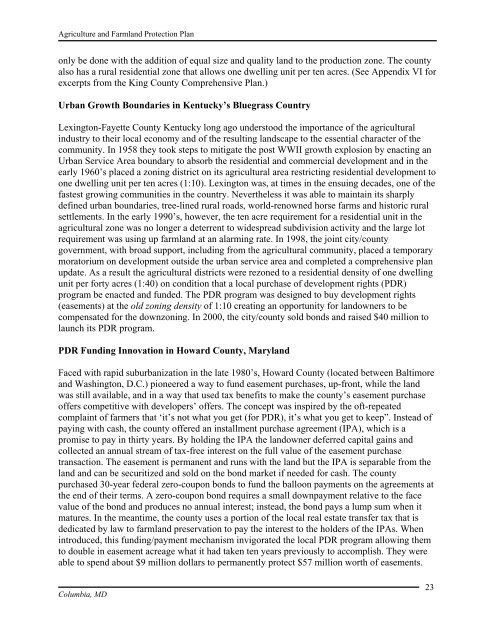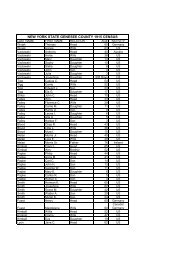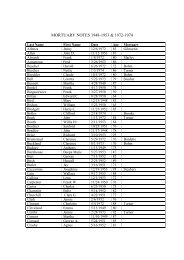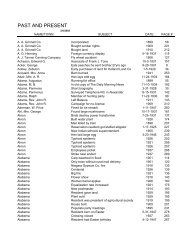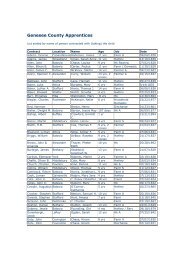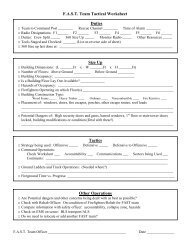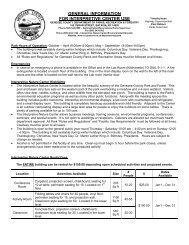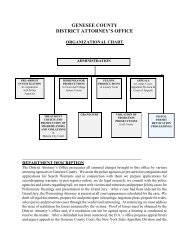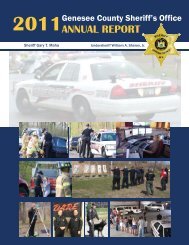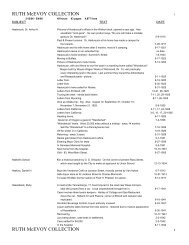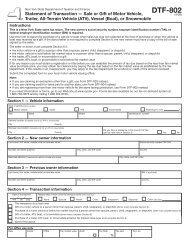Genesee County Agricultural and Farmland Protection Plan
Genesee County Agricultural and Farmland Protection Plan
Genesee County Agricultural and Farmland Protection Plan
Create successful ePaper yourself
Turn your PDF publications into a flip-book with our unique Google optimized e-Paper software.
Agriculture <strong>and</strong> Farml<strong>and</strong> <strong>Protection</strong> <strong>Plan</strong><br />
only be done with the addition of equal size <strong>and</strong> quality l<strong>and</strong> to the production zone. The county<br />
also has a rural residential zone that allows one dwelling unit per ten acres. (See Appendix VI for<br />
excerpts from the King <strong>County</strong> Comprehensive <strong>Plan</strong>.)<br />
Urban Growth Boundaries in Kentucky’s Bluegrass Country<br />
Lexington-Fayette <strong>County</strong> Kentucky long ago understood the importance of the agricultural<br />
industry to their local economy <strong>and</strong> of the resulting l<strong>and</strong>scape to the essential character of the<br />
community. In 1958 they took steps to mitigate the post WWII growth explosion by enacting an<br />
Urban Service Area boundary to absorb the residential <strong>and</strong> commercial development <strong>and</strong> in the<br />
early 1960’s placed a zoning district on its agricultural area restricting residential development to<br />
one dwelling unit per ten acres (1:10). Lexington was, at times in the ensuing decades, one of the<br />
fastest growing communities in the country. Nevertheless it was able to maintain its sharply<br />
defined urban boundaries, tree-lined rural roads, world-renowned horse farms <strong>and</strong> historic rural<br />
settlements. In the early 1990’s, however, the ten acre requirement for a residential unit in the<br />
agricultural zone was no longer a deterrent to widespread subdivision activity <strong>and</strong> the large lot<br />
requirement was using up farml<strong>and</strong> at an alarming rate. In 1998, the joint city/county<br />
government, with broad support, including from the agricultural community, placed a temporary<br />
moratorium on development outside the urban service area <strong>and</strong> completed a comprehensive plan<br />
update. As a result the agricultural districts were rezoned to a residential density of one dwelling<br />
unit per forty acres (1:40) on condition that a local purchase of development rights (PDR)<br />
program be enacted <strong>and</strong> funded. The PDR program was designed to buy development rights<br />
(easements) at the old zoning density of 1:10 creating an opportunity for l<strong>and</strong>owners to be<br />
compensated for the downzoning. In 2000, the city/county sold bonds <strong>and</strong> raised $40 million to<br />
launch its PDR program.<br />
PDR Funding Innovation in Howard <strong>County</strong>, Maryl<strong>and</strong><br />
Faced with rapid suburbanization in the late 1980’s, Howard <strong>County</strong> (located between Baltimore<br />
<strong>and</strong> Washington, D.C.) pioneered a way to fund easement purchases, up-front, while the l<strong>and</strong><br />
was still available, <strong>and</strong> in a way that used tax benefits to make the county’s easement purchase<br />
offers competitive with developers’ offers. The concept was inspired by the oft-repeated<br />
complaint of farmers that ‘it’s not what you get (for PDR), it’s what you get to keep”. Instead of<br />
paying with cash, the county offered an installment purchase agreement (IPA), which is a<br />
promise to pay in thirty years. By holding the IPA the l<strong>and</strong>owner deferred capital gains <strong>and</strong><br />
collected an annual stream of tax-free interest on the full value of the easement purchase<br />
transaction. The easement is permanent <strong>and</strong> runs with the l<strong>and</strong> but the IPA is separable from the<br />
l<strong>and</strong> <strong>and</strong> can be securitized <strong>and</strong> sold on the bond market if needed for cash. The county<br />
purchased 30-year federal zero-coupon bonds to fund the balloon payments on the agreements at<br />
the end of their terms. A zero-coupon bond requires a small downpayment relative to the face<br />
value of the bond <strong>and</strong> produces no annual interest; instead, the bond pays a lump sum when it<br />
matures. In the meantime, the county uses a portion of the local real estate transfer tax that is<br />
dedicated by law to farml<strong>and</strong> preservation to pay the interest to the holders of the IPAs. When<br />
introduced, this funding/payment mechanism invigorated the local PDR program allowing them<br />
to double in easement acreage what it had taken ten years previously to accomplish. They were<br />
able to spend about $9 million dollars to permanently protect $57 million worth of easements.<br />
Columbia, MD<br />
23


